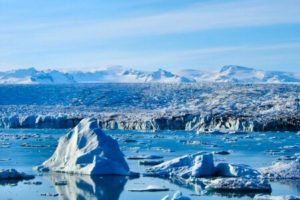Ice
Story tips from the US Department of Energy’s Oak Ridge National Laboratory — March 2011
When a Rhode-Island-sized ice chunk separates from Greenland, is the calving due to typical seasonal variations or a long-term warmer world? A project called the Scalable, Efficient, and Accurate Community Ice Sheet Model, or SEACISM, on the Jagua…
Algal antifreeze makes inroads into ice
Sea-ice algae — the important first rung of the food web each spring in places like the Arctic Ocean — can engineer ice to its advantage, according to the first published findings about this ability.
The same gel-like mucus secreted by sea-i…
Ancient catastrophic drought leads to question: How severe can climate change become?
How severe can climate change become in a warming world?
Worse than anything we’ve seen in written history, according to results of a study appearing this week in the journal Science.
An international team of scientists led by Curt Stager of…
Ice cores yield rich history of climate change
On Friday, Jan. 28 in Antarctica, a research team investigating the last 100,000 years of Earth’s climate history reached an important milestone completing the main ice core to a depth of 3,331 meters (10,928 feet) at West Antarctic Ice Sheet Divi…
UF study of lice DNA shows humans first wore clothes 170,000 years ago
GAINESVILLE, Fla. — A new University of Florida study following the evolution of lice shows modern humans started wearing clothes about 170,000 years ago, a technology which enabled them to successfully migrate out of Africa.
Principal investi…
What can ice reveal about fire?
Scientists studying a column of Antarctic ice spanning 650 years have found evidence for fluctuations in biomass burning–the consumption of wood, peat and other materials in wildfires, cooking fires and communal fires–in the Southern Hemisph…
AGU journal highlights — Nov. 2, 2010
The following highlights summarize research papers that have been recently published in Geophysical Research Letters (GRL), Water Resources Research (WRR), and Journal of Geophysical Research-Atmospheres (JGR-D).
1. Toxic levels of chemicals …
NOAA: Tagged narwhals track warming near Greenland
In a research paper published online Saturday in the Journal of Geophysical Research Oceans, a publication of the American Geological Union (AGU), scientists reported the southern Baffin Bay off West Greenland has continued warming since wintertime …
UF research gives clues about carbon dioxide patterns at end of Ice Age
GAINESVILLE, Fla. — New University of Florida research puts to rest the mystery of where old carbon was stored during the last glacial period. It turns out it ended up in the icy waters of the Southern Ocean near Antarctica.
The findings have i…
UBC underwater robot to explore ice-covered ocean and Antarctic ice shelf
Researchers at the University of British Columbia are deploying an underwater robot to survey ice-covered ocean in Antarctica from October 17 through November 12.
Scientists predict that the sea ice area around Antarctica will be reduced by more t…
Pristine rainforests are ‘biogeochemical reactors’
A multinational team that includes a North Carolina State University researcher has found another piece of the atmospheric puzzle surrounding the effects of aerosol particles on climate change. Their findings will contribute to our ability to more a…

